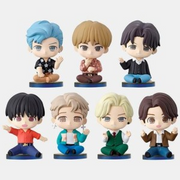"Exploring the Dynamic Evolution of K-Pop Music Trends"

The Latest Trends in K-Pop Music: A Deep Dive
K-Pop, short for Korean Pop music, has taken the world by storm. This genre, characterized by its catchy melodies, synchronized dance routines, and high-energy performances, is not only a staple of South Korean culture but has also become a global phenomenon. In this blog post, we'll explore the latest trends and developments shaping the K-Pop music scene today.
The Rise of New Artists
The K-Pop industry is constantly evolving, with new artists debuting almost every week. Among the noteworthy newcomers are groups that have quickly gained traction on social media platforms. The power of social media cannot be overstated, as it provides artists with a direct line to their fans. Through platforms like TikTok and Twitter, new groups can showcase their talents, build a following, and engage with audiences in real time.
One of the exciting aspects of this new wave is the increase in diversity within groups. Many new bands are featuring members from different cultural backgrounds, which adds a fresh dynamic to their music and performances. This trend not only broadens the appeal of K-Pop globally but also promotes inclusivity in the industry.
Musical Innovations
Musically, K-Pop is known for its eclectic style, combining various genres such as hip-hop, R&B, EDM, and even traditional Korean music. The latest songs reflect this fusion, with innovative beats and melodies that captivate listeners. Producing companies are investing in high-quality production to ensure that each track stands out in a saturated market.
K-Pop artists are also experimenting with different lyrical themes. While love and heartbreak remain popular topics, there is a noticeable shift towards addressing social issues, personal struggles, and mental health awareness in their lyrics. This deeper engagement with real-world topics resonates with fans and adds an emotional layer to their music.
The Influence of Technology
In recent years, the integration of technology in K-Pop has become increasingly prominent. Virtual concerts, augmented reality (AR), and artificial intelligence (AI) are changing the landscape of how music is produced and performed. Virtual concerts gained popularity during the pandemic, allowing fans worldwide to enjoy live performances from the comfort of their homes. This innovative approach has opened new revenue streams for artists and agencies and has enabled them to reach a broader audience.
Furthermore, AI-generated music is beginning to find its place within the K-Pop industry. With advancements in technology, producers are using AI to analyze trends and predict what types of music will resonate with listeners. This data-driven approach is helping artists create catchy songs that are more likely to become hits.
Fan Engagement and Communities
K-Pop fandoms are some of the most dedicated and passionate communities in the world. Fans, often referred to as “stans,” play a crucial role in an artist's success. Recent trends show that fan engagement is evolving; for example, fan-driven campaigns on social media platforms have proven effective in promoting new releases, merchandise, and events.
Groups are now more aware of their fans' power and are actively involving them in various activities. Online voting, fan meetings, and interactive content on platforms like V Live and Weverse provide intimate connections between artists and their fans. This level of engagement fosters loyalty and creates a supportive community around the artists, further driving the popularity of K-Pop as a genre.
Global Collaborations
The global reach of K-Pop has led to a surge in collaborations with international artists. These partnerships not only expand the music's audience but also enrich the artists' creative portfolios. Such collaborations often incorporate diverse musical styles, making songs appealing to a wider demographic. Artists like BTS and BLACKPINK have set a precedent with their successful collaborations featuring major Western artists, bridging cultural gaps and promoting cross-cultural exchanges.
As the K-Pop genre continues to expand internationally, it’s likely we’ll see even more artists from different countries joining forces, leading to exciting new music that encapsulates a global sound.
The Impact of Fashion and Visuals
K-Pop is not just about music; it’s an entire cultural phenomenon that encompasses fashion and visuals. Idols are often seen as trendsetters, influencing not only fashion choices but also beauty standards around the world. The latest trends highlight bold styles, vibrant colors, and unique concepts that push the boundaries of traditional clothing norms.
The visual aspect of K-Pop also plays a significant role in its appeal. High-production music videos feature stunning cinematography, intricate choreography, and visually striking concepts that leave a lasting impression. Fans are not just listening to the music; they are experiencing an entire visual feast that captivates their attention.
Conclusion
The evolution of K-Pop is an exciting phenomenon that reflects broader trends in music and culture. With new artists rising, innovative sounds, and a devoted fanbase, the genre continues to thrive and influence the global music scene. As K-Pop embraces technological advancements and cultural exchanges, the future looks bright for both artists and fans alike. Whether you're a die-hard K-Pop enthusiast or a curious newcomer, there's never been a more exhilarating time to dive into the vibrant world of K-Pop music.
```










































